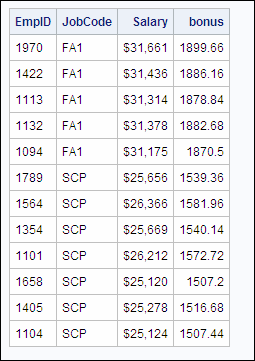Writing a PROC SQL Step
Overview
Before creating a query, you must first reference
the library in which your table is stored. Then you write a PROC SQL
step to query your table.
|
General form, basic
PROC SQL step to perform a query:
PROC SQL;
SELECT column-1<,...column-n>
FROM table-1|view-1<,...table-n|view-n>
<WHERE expression>
<GROUP
BY column-1<,
... column-n>>
<ORDER
BY column-1<,...
column-n>>;
PROC SQL
invokes the SQL procedure
SELECT
specifies the column(s)
to be selected
FROM
specifies the table(s)
to be queried
WHERE
subsets the data
based on one or more conditions
GROUP BY
classifies the data
into groups based on the specified column(s)
ORDER BY
sorts the rows that
the query returns by the value(s) of the specified column(s).
|
CAUTION:
Unlike other SAS procedures
the order of clauses with a SELECT statement in PROC SQL is important.
Clauses must appear in the order shown above.
Note: A query can also include
a HAVING clause, which is introduced at the end of this chapter. To
learn more about the HAVING clause, see
Performing Advanced Queries Using PROC SQL.
The SELECT Statement
The SELECT statement, which follows the PROC SQL statement,
retrieves and displays data. It consists of clauses that begin with
a keyword, and is followed by one or more components. The SELECT statement
in the following sample code contains four clauses: the required clauses
SELECT and FROM, and the optional clauses WHERE and ORDER BY. The
end of the statement is indicated by a semicolon.
proc sql; |-select empid,jobcode,salary, | salary*.06 as bonus |----from sasuser.payrollmaster |----where salary<32000 |----order by jobcode;
Note: A PROC SQL step that contains
one or more SELECT statements is referred to as a PROC SQL query.
The SELECT statement is only one of several statements that can be
used with PROC SQL.
The following PROC SQL
query creates the output report that is shown:
proc sql;
select empid,jobcode,salary,
salary*.06 as bonus
from sasuser.payrollmaster
where salary<32000
order by jobcode; |
 |
A PROC SQL query produces
a result set that can be output as a report, a table, or a PROC SQL
view.
Note: The CREATE TABLE statement
is introduced later in this chapter. You can learn about creating
tables in
Creating and Managing Tables Using PROC SQL. You can learn
more about PROC SQL views in
Creating and Managing Views Using PROC SQL.
You learn more about
the SELECT statement in the following sections.
..................Content has been hidden....................
You can't read the all page of ebook, please click here login for view all page.
